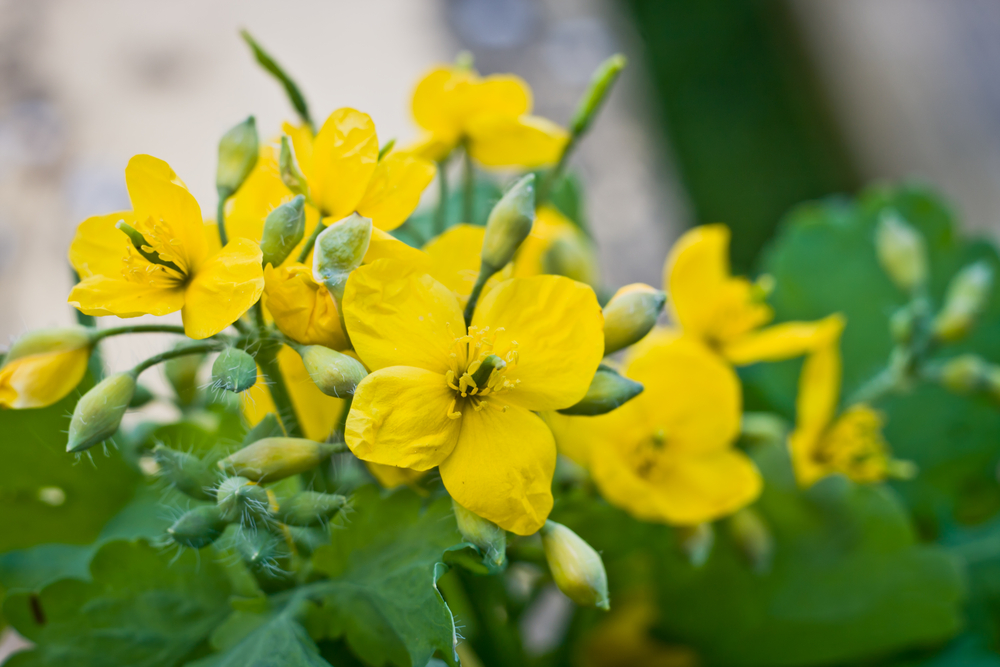Greater celandine (Chelidonium majus) is a perennial herb with yellow flowers and green leaves, which has been used for centuries in traditional medicine due to its therapeutic properties. Although it is commonly found along roadsides and in gardens, greater celandine is a plant with numerous benefits, especially for the skin.
In this article, we will explore what greater celandine is, how it can help the skin, and how you can use it to improve the appearance and health of your skin.
What is greater Celandine?
Greater celandine is a perennial plant that grows in temperate regions of Europe, Asia, and North America. It has a long history of use in folk medicine to treat various skin conditions, including warts, blemishes, rashes, and skin lesions. The plant contains alkaloids and chemical compounds that have antiseptic, antibacterial, antiviral, and anti-inflammatory effects.
Greater celandine has an orange or yellow sap that is often used to treat skin lesions. However, it is important to note that this sap can be irritating to the skin, so it should be used cautiously and in small amounts.
Benefits of greater Celandine for skin
Greater celandine is appreciated for its many beneficial properties for skin health. Here are some of the most important ways in which this plant can be helpful for skincare:
1. Treatment for warts and blemishes
One of the oldest and most popular uses of greater celandine is the treatment of warts and blemishes. The sap of greater celandine is known to have an eradicating effect on these skin growths. When applied directly to the wart, the sap helps destroy the abnormal tissue and eliminate the wart. It is important to apply greater celandine carefully to avoid irritation to the healthy surrounding skin.
2. Antibacterial and antiviral properties
Greater celandine contains active substances that have antibacterial and antiviral effects. These properties are useful in treating infectious acne or other skin rashes caused by bacteria or viruses. Applying an extract of greater celandine to affected areas can help prevent infections and reduce skin inflammation.
3. Reduces inflammation and irritation
Due to its anti-inflammatory properties, greater celandine can help soothe irritated or inflamed skin. It can be useful in treating conditions such as dermatitis, eczema, or psoriasis, as it helps reduce redness, swelling, and itching. Greater celandine can also be used to treat minor sunburns or other forms of skin irritation.
4. Treatment for scalp conditions
Greater celandine is also effective for scalp care, particularly in cases of dandruff or seborrhea. It can be applied as an infusion or essential oil to the scalp to clean the pores and reduce inflammation. Its antimicrobial properties can help combat bacteria and fungi that cause scalp issues.
5. Antioxidant and anti-aging action
Greater celandine is also known for its antioxidant effects. These properties help protect the skin from oxidative stress caused by exposure to pollution, UV radiation, or other external factors. The antioxidants in greater celandine help prevent premature skin aging by reducing the appearance of wrinkles and fine lines.
6. Treats skin lesions and wounds
The sap of greater celandine is used to treat minor skin lesions and wounds due to its healing-stimulating effect. It helps accelerate the regeneration of skin cells, preventing infections and reducing scarring from wounds. It can also be useful for treating bruises and contusions.
7. Eases acne symptoms
Thanks to its antibacterial properties, greater celandine can be an effective remedy for treating acne. Extracts of greater celandine applied to affected areas can help clean the skin and prevent new breakouts. Additionally, its anti-inflammatory effect helps reduce redness and swelling associated with severe acne.
How to use greater Celandine for skin
There are several ways to use greater celandine to benefit from its skin properties:
- Fresh sap: Apply fresh greater celandine sap directly to warts or blemishes, being careful to avoid contact with healthy skin. Leave the sap on for a few hours or overnight, then wash the area with warm water.
- Greater Celandine infusion: You can prepare an infusion from dried greater celandine leaves. Boil water and add a teaspoon of dried leaves. Let the infusion cool and use it to cleanse areas affected by rashes or irritation.
- Greater Celandine oil: Essential greater celandine oil is often used in combination with other oils for massages or skin applications. It is effective in treating inflammation and reducing skin irritation.
- Compresses: You can apply warm compresses with greater celandine infusion to inflamed or irritated areas of the skin to reduce redness and itching.
Precautions and warnings
Although greater celandine has many benefits for the skin, it should be used with caution, especially the fresh sap, as it can be irritating to sensitive skin. It is recommended to perform a patch test on a small area of skin before applying the product to a larger surface.
Additionally, it is important to consult a specialist before using greater celandine to treat severe skin conditions such as severe eczema or psoriasis.

Greater celandine is a plant with many benefits for skin health, offering antibacterial, anti-inflammatory, and cell regeneration effects. Whether you use it to treat warts, acne, or to relieve inflammation and irritation, greater celandine can be an effective natural remedy for skincare.
However, it is important to use it carefully and consult a specialist for more severe skin conditions.

